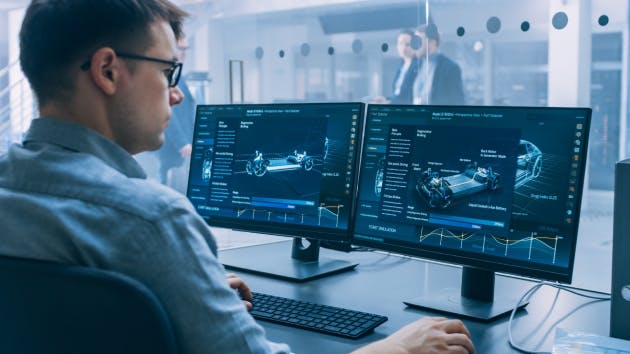This webinar discusses how adopting Model-based Systems Engineering (MBSE) helps automotive manufacturers remain competitive, agile, and cost-effective while tackling challenges such as quality, increased regulation, sustainability, and cost. Illustrated with the example of an electric drive, our automotive MBSE experts will explain how to overcome challenges and ensure that the digital thread of requirements remains in the modeling environment from requirements to design, analysis, verification and validation. Register to watch now!
Overcome quality, increased regulation, sustainability, and cost challenges using MBSE
The automotive industry's increased product and process complexity urge many automotive OEMs and suppliers to reevaluate their current product development processes. Deploying a Model-based Systems Engineering (MBSE) approach, connects systems engineering with the rest of the development organization, improving collaboration and decision-making. While the advantages are plentiful, a systems engineering approach encounters challenges: only some requirements can be modeled with the level of accuracy needed, and a heterogeneous mix of modeling and analysis tools from various sources makes it difficult to link all of them synchronously.
Using the example of an electric drive, MBSE experts illustrate how to link all requirements to the corresponding models, ensuring a digital thread of requirements in the modeling environment from requirements to design, analysis, verification and validation.
- In the early stages: to make an informed decision and arrive at a baseline architecture and refined system requirements that later become a blueprint for detailed design and simulation.
- In the connected engineering stage: to enable a better product architecture and design options exploration, optimization, and concept selection, including performance evaluation and design trade-offs.
- In the connected engineering and product validation stage: to ensure that the simulation and testing workflows are well integrated with requirements, system architecture, ECAD/MCAD, and the rest of the process, making it easier to understand and communicate the design and requirements of the electric drive system throughout the development organization.
Key takeaways:
- Ensure compliance with regulations and standards
- Reduce risk and increase innovation using a digital thread that remains in the modeling environment
- Improve collaboration and decision-making based on integrated simulation and testing workflows
- Obtain a better product architecture, explore design options, and evaluate the performance and trade-offs
- Improve efficiency and effectiveness by tracking the entire development process, reducing errors, and rework
Register now and learn how to remain competitive, agile, and cost-effective while tackling the challenges of quality, increased regulation, sustainability, and cost.
À propos des intervenants

Vijay Singh
MBSE Solution Consultant
Singh is an MBSE expert consultant in the industry strategy team of the simulation and test solutions segment. In this role, he is responsible for enabling industry-leading customers to successfully integrate their simulation and test workflows as part of their enterprise MBSE solution.

Steven Dom
Directeur des solutions pour l'industrie automobile
Steven Dom travaille chez Siemens Industry Software (anciennement LMS International) depuis plus de 20 ans, où il a occupé divers postes dans les domaines de l'ingénierie, de la gestion de l'ingénierie, de la gestion des produits et des ventes. Il est actuellement responsable du développement de l'activité de Siemens Industry Software pour le secteur de l'automobile et se concentre sur les points suivants :
La gestion des relations avec les clients internationaux auprès des cadres et des dirigeants -
Le développement d'une feuille de route stratégique pour les différentes branches du logiciel, du matériel et des services -
Le conseil en technologie client et en processus d'entreprise -
Le développement des véhicules hybrides et électriques -
Le conseil en matière de NVH, d'acoustique et d'efficacité énergétique.
